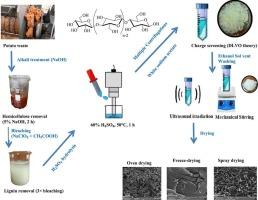马铃薯淀粉工业中马铃薯废浆制备水分散纤维素纳米晶干粉及表征:干燥方法的影响
Q1 Environmental Science
引用次数: 0
摘要
本研究采用醋酸钠(NaOAc)作为中和电解质,从马铃薯加工副产物中分离纤维素纳米晶(CNC)粉末。NaOAc方法的CNCs产率为72.3±2.1%,与传统的硫酸水解产率68.5±3.4%相竞争。该方法显著提高了工艺效率,减少了48小时的净化时间,通过消除透析步骤,减少了大约60%的总用水量。醋酸钠有效地屏蔽了碳纳米管表面的负电荷,促进了DLVO理论下的快速沉淀。对下游干燥的影响进行了严格评估:喷雾干燥生产的cnc具有优异的水分散性,其特征是平均再分散粒径为68 nm,形态均匀,而冷冻干燥为cnc提供了增强的热稳定性(开始降解温度为298°C,峰值为353°C)。结构分析证实了所有样品中纤维素Iβ结晶度的保存,结晶度指数与干燥强度成反比,范围从72.8%(喷雾干燥)到78.5%(烘箱干燥)。naoac辅助技术提供了一种可扩展且经济可行的解决方案,可将马铃薯废物转化为高价值的cnc,干燥方法(喷雾或冷冻)的选择取决于对胶体分散性或热性能的特定应用要求。本文章由计算机程序翻译,如有差异,请以英文原文为准。

Preparation and characterisation of water dispersible cellulose nanocrystals (CNC) dry powder from potato waste pulp of the potato starch industry: effect of drying method
This study introduces a novel and efficient dialysis-free methodology for isolating cellulose nanocrystal (CNC) powder from potato processing byproducts, employing sodium acetate (NaOAc) as a neutralising electrolyte. The NaOAc approach yielded 72.3 ± 2.1 % CNCs, a value competitive with the traditional sulfuric acid hydrolysis yield of 68.5 ± 3.4 %. This method significantly enhanced process efficiency, reducing the purification time by 48 h and decreasing total water consumption by approximately 60 % by eliminating the dialysis step. Sodium acetate effectively screened the negative surface charges of the CNCs, facilitating rapid precipitation governed by DLVO theory. The influence of downstream drying was critically evaluated: spray drying produced CNCs with superior water dispersibility, characterised by a mean redispersed particle size of 68 nm and a uniform morphology, while freeze drying provided CNCs with enhanced thermal stability (onset degradation temperature of 298 °C; peak at 353 °C). Structural analysis confirmed the preservation of cellulose Iβ crystallinity across all samples, with crystallinity indices inversely related to the drying intensity, ranging from 72.8 % (spray-dried) to 78.5 % (oven-dried). The NaOAc-assisted technique presents a scalable and economically viable solution for valorising potato waste into high-value CNCs, with the selection of drying method (spray vs. freeze) being guided by application-specific requirements for either colloidal dispersibility or thermal performance.
求助全文
通过发布文献求助,成功后即可免费获取论文全文。
去求助
来源期刊

Bioresource Technology Reports
Environmental Science-Environmental Engineering
CiteScore
7.20
自引率
0.00%
发文量
390
审稿时长
28 days
 求助内容:
求助内容: 应助结果提醒方式:
应助结果提醒方式:


